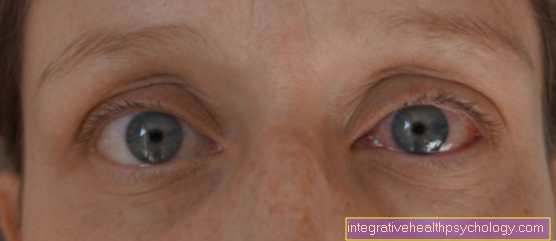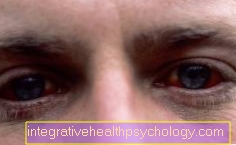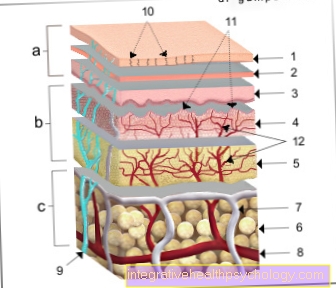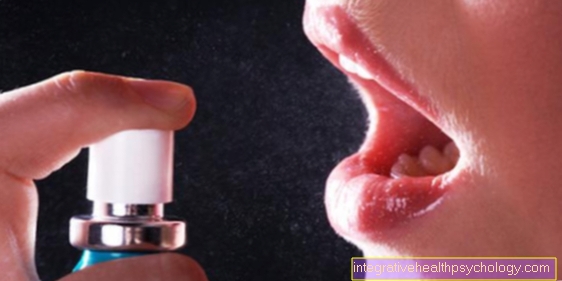Conjunctivitis
Synonyms in a broader sense
Conjunctivitis, conjunctivitis
English: conjunctivitis, pinkeye
definition
(Conjunctiva = conjunctiva of the eye; -itis = inflammation)
Inflammation of the conjunctiva is one of the most common diseases of the eye. The eye itches, is red and gives off secretions. It can be triggered among other things by bacteria, viruses, an allergy or external stimuli such as dry air. Depending on the cause, it may or may not be contagious.
For general information on the subject of "inflammation of the eye" please also read: Inflammation of the eye

What types of conjunctivitis are there?
Basically, conjunctivitis can be divided into inflammatory and non-inflammatory conjunctivids depending on the cause. These are each subdivided again.
Non-inflammatory conjunctivitis:
- unspecific
- allergic
Inflammatory conjunctivitis:
- Neonatal conjunctivitis
- Bacterial
- Viral
The doctor can determine which type of conjunctivitis is present based on the symptoms: Infectious conjunctivitis is particularly often responsible for the secretion of secretion or the development of protrusions in the conjunctiva.
The infection usually goes unnoticed when those affected rub their itchy eyes and the pathogens then pass on through their hands. This can be done using doorknobs or other objects that many people touch with their hands. Bacteria or viruses can also be passed on through direct hand contact. Shaking hands should therefore be avoided if there is conjunctivitis. Rubbing the eyes should also be avoided because there is a very high risk that the pathogens from one eye will not only be transmitted to other people, but also to the other eye. Regular hand disinfection is therefore also very important. Within a family, care should be taken to use their own towels, washcloths, etc., as there is also a high risk that the pathogen will spread.
Read more on the subject at: How contagious is conjunctivitis?
Detecting conjunctivitis
What are the symptoms of conjunctivitis?
In conjunctivitis, the following so-called key symptoms come to the fore:
- the "red eye" or red eyelid
It comes about through an increased filling of the vessels of the conjunctiva. - secretion
Watery, slimy or purulent secretions develop, especially if the cause is bacterial. - swelling
The conjunctiva can be so swollen that it oozes out of the fissure of the eyelid. - "Paving stones"
Flat protrusions of the conjunctiva, which are reminiscent of cobblestones, appear especially under the lid. These so-called papillae are typical for conjunctivitis caused by an allergy. - follicle
Follicles are collections of inflammatory cells in the conjunctiva.
You can find different symptoms in conjunctivids of different origins. Therefore one has to consider specific symptoms with the different forms of conjunctivitis. Inflammation of the conjunctiva can also be accompanied by pain in the corner of the eye.
You might also be interested in:
- Eye pain
- Conjunctival tumor
- Pus in the eye
- Watery eyes
How is conjunctivitis diagnosed?
The diagnosis of conjunctivitis is based on the main symptoms “reddened eye”, increased secretion of fluid and swelling of the conjunctiva.
Usually there is also an itchiness. The diagnosis of conjunctivitis is often a visual diagnosis by the ophthalmologist. Eye diagnosis means that the doctor can make the diagnosis at first glance or express a specific suspicion. The distinction between the various forms of the subjunctivids is more difficult.
In order to assess the various manifestations of the sometimes nodular changes in the conjunctiva under the lids, the doctor must turn the eyelid outwards (ectropion).
Treat conjunctivitis
How is conjunctivitis treated?
Since conjunctivitis (Conjunctivitis) can be triggered by several causes, there are also different treatment approaches.
You should be very careful with self-treatment as you cannot identify the exact trigger yourself and thus cannot treat accordingly. Conjunctivitis is usually treated locally, so only eye ointments or drops are applied to the affected eye.
The drug Vividrin® eye drops is used to treat symptoms in the eye of conjunctivitis. Read more on the subject below: Vividrin acute eye drops
Dexa-gentamicin eye drops also help relieve symptoms of conjunctivitis. Read more about this under: Dexa-gentamicin eye drops
Read more on the topic: Conjunctivitis treatment, floxal
How is irritable conjunctivitis treated?
Irritant conjunctivitis can result from external stimuli such as dust, smoke or drafts, but also from a changed composition of the tear fluid. One possible cause of this is the use of eye drops that are not recommended by the ophthalmologist. Here, external stimuli should be avoided as quickly as possible, then the symptoms usually subside after a few days.
If dry eyes have led to conjunctivitis, tear substitutes can help keep the eye moist and reduce the discomfort. Eye drops with hyaluronic acid are used here for therapy.
Read more on the subject at: Eye drops for dry eyes.
How is allergic conjunctivitis treated?
Allergic conjunctivitis is often associated with hay fever. Here it makes sense to work with an allergist who may carry out desensitization. The conjunctivitis caused by a rash or the so-called spring conjunctivitis cannot be alleviated by this. Here the patient has to accept the symptoms and, in cooperation with an ophthalmologist, find a therapy that is as effective as possible and with few side effects. Preparations containing cortisone often help to at least temporarily relieve the symptoms.
In the allergic Conjunctivitis there are different types:
- Of the Hay fever conjunctivitis is based on an allergy to pollen. It is typically associated with an allergic runny nose. Patients are severely affected by tearing, sneezing, conjunctival swelling, and a foreign body sensation. You can also read our topic hay fever.
- Is there a atopic Conjunctivitis before, it is an inflammation of the conjunctiva in children, z. E.g. suffering from neurodermatitis. The reaction of the eyes is based on the reaction to toxins from bacteria.
The specific symptoms of this disease include the formation of nodules on the conjunctiva, which can grow into the cornea and leave scars there. Patients can be very dazzled at the beginning.
Cosmetics or house dust can also cause inflammation of the conjunctiva.
Read more on the subject at: Therapy for hay fever and eye ointment with cortisone
How is infectious conjunctivitis treated?
Conjunctivitis caused by bacteria or fungi is relatively rare. Here an antibiotic is used for bacteria or an antifungal agent for fungi.
In the case of bacterial conjunctivities, eye drops and ointments containing antibiotics can be given, with eye drops being the most common method. These are instilled directly into the affected eye and are used for around 3 to 5 days in most cases.
Learn more about how Floxal eye drops.
However, if special bacteria, the chlamydia, are responsible for the conjunctivitis, the treatment duration is about 3 weeks. Chlamydia are the causative agents of sexually transmitted diseases and are transmitted through body fluids. Therefore, when detecting chlamydia, the partner must always be treated as well. Here it is particularly important to adhere to the prescribed duration of treatment, as chronic clouding of the cornea can occur if it does not heal completely.
Please also read our article on this Chlamydia in men
Viruses can also cause conjunctivitis. These often heal on their own and occur in conjunction with other symptoms of illness that are triggered by viruses, i.e. with a flu-like infection. The so-called adenoviruses, for which there is no special therapy, are particularly contagious. After waiting about 2 weeks, the symptoms should go away on their own. During this time, eye drops containing cortisone may be used temporarily to relieve the itching and inflammation. In addition, the herpes simplex viruses can cause conjunctivitis. In these cases, acyclovir as an eye ointment or tablets can often be used effectively.
Read more on the topic: Therapy of conjunctivitis
Read more on the topic Bepanthen® eye drops
What home remedies can help with conjunctivitis?
A variety of home remedies are known for treating conjunctivitis. They all have in common that they should only be used within a limited framework. If after 3 days the conjunctivitis has not subsided after treatment with home remedies, a doctor should be consulted immediately. Furthermore, it is essential that hygiene measures are strictly observed.
A symptom-relieving solution can be made from the turmeric tuber or ready-made powder of the root with boiling water after 10-15 minutes of steeping. Eyebright also helps with conjunctivitis. This is also boiled with water, which is then used to soak a compress.
Brewed black tea bags help after storage in the refrigerator as cooling compresses on the eye against symptoms such as burning sensation.
Oak bark and fennel can also be used. The oak bark is used to soak compresses after boiling with water. The same goes for the fennel. While the oak bark has a disinfecting effect, the fennel mainly helps against swelling of the eyelids.
Sage, chamomile and marigold are also known as home remedies. Quark compresses and washing the eyes with onion milk are also said to have positive effects.
All of these methods should be used with caution and only as directed to prevent additional irritation or even damage to the eye. If you are unsure about the treatment or if the symptoms worsen, a doctor must be consulted.
For more information, check out our article: Home Remedies for Conjunctivitis
Preventing conjunctivitis
What are the causes of conjunctivitis?
Conjunctivitis caused by adenoviruses in particular spreads very quickly and often causes an epidemic in kindergartens and schools. It is therefore very important to adequately treat conjunctivitis caused by pathogens before the child is allowed to have contact with other children again.
The causes of conjunctivitis must be clarified by a pediatrician. Appropriate therapy can only be initiated once the cause has been clarified. In the case of inflammation caused by bacteria, an application period of 2 to 3 days is usually sufficient until the child is allowed to go to kindergarten or school again. However, if the eyes are still stuck together and severely reddened, the pediatrician should be visited again.
Babies can catch bacteria in the birth canal that lead to conjunctivitis. These include above all the gonococci, which trigger gonorrhea. If the mother is sick, the bacterium can be transmitted to the baby during birth and the conjunctivitis must be treated quickly to prevent additional corneal involvement. As a precaution, eye drops can also be given to the baby after birth to prevent the outbreak of conjunctivitis.
Even if the mother carries chlamydia, it can be passed on to the baby and lead to conjunctivitis. Women often do not know anything about their disease, as it is symptom-free in many cases. In addition, neonatal conjunctivitis can be triggered by herpes viruses, which are also transmitted in the birth canal.
Is one by Bacteria caused Conjunctivitis there are several possible pathogens.
A Viral conjunctivitis is highly contagious. Usually it is caused by so-called adenoviruses. This form of the highly contagious almost always begins Conjunctivitis in only one eye.
In rare cases, the Conjunctivitis can also be caused by fungi or parasites.
Bacteria are usually the cause of neonatal conjunctivitis (gonococcal trigger for gonorrhea; chlamydia or pseudomonas). Viruses such as E.g. or herpes viruses are possible triggers. All of these pathogens are transmitted to the baby at birth and are therefore contagious.
If conjunctivitis is caused by gonococci, there is a particularly large accumulation of pus in the severely swollen eyelids.
At a Conjunctivitis , which was caused by chlamydia, expresses itself through the main symptoms. The pathogen can only be detected by a smear. All of these pathogens can of course also lead to this disease in adults.
Read more on the subject at:
- Conjunctivitis in the baby
and - Conjunctivitis in toddlers.
What are the causes of non-infectious conjunctivitis?
A unspecific conjunctivitis Often caused by dry eyes, for example due to insufficient tear fluid, overexertion or external stimuli (e.g. smoke) caused. Contact lenses that have been worn or dirty for a long time can also be a trigger. The main symptoms are the feeling of a foreign body and sudden tears.
How can you prevent conjunctivitis?
Conjunctivitis can be prevented by avoiding rubbing your eyes with dirty fingers. There are pathogens on our skin that are part of the normal skin flora, but have a disease value in the eye.
Even if you have had contact with infectious patients, your hands should be washed thoroughly afterwards.
If there is an allergy, the allergen should be avoided to avoid the associated conjunctivitis.
Conjunctivitis course
How long does conjunctivitis last?
The duration of conjunctivitis depends very much on the root cause from. If it is a simple irritation from dust, wind or smoke, it usually heals within few days out. It is important that attention is paid to avoiding the stimuli and good eye hygiene (washing hands, do not rub).
If the problem persists after several days, a doctor must be consulted. In this case, there is a possibility that there are other causes. In the case of bacteria or fungi as the causes, the healing process usually only takes around the with adequate drug treatment 4-5 days.
When viruses are the cause, conjunctivitis can be up to two weeks stop. When the suspicion on Herpes viruses as the cause must be treated with medication, otherwise there is a risk of Chronification and long-term damage the conjunctiva and the rest of the eye. In small children, conjunctivitis often comes home with them from kindergarten.
You may also be interested in the following article: Conjunctivitis in toddlers
When treated with eye drops containing antibiotics these mostly heal in 2-3 days without consequences. It is important at all times that a doctor is contacted if the non-drug therapy fails. The pathogens can besides the conjunctiva also other shares of the eye affected and closed critical inflammation of the entire eye.
What is the prognosis for conjunctivitis?
The bacterial conjunctivitis heals under therapy after about two or three days of treatment.
If there is a viral conjunctivitis, it can take a little longer before all symptoms have disappeared under therapy. If the disease was triggered by herpes viruses, the inflammation can recur despite therapy.
One complication of conjunctivitis is superinfection. Superinfection means that in addition to the causative pathogens, other pathogens are added, which clearly complicates treatment. In addition, the cornea can be involved. This is dangerous in that there is a possibility of corneal opacity.
In the case of protracted conjunctivitis, there can also be an increase in tissue triggered by the inflammation. This excessive new tissue formation can grow over the cornea and is known as pannus on the eye. The pannus can then also lead to clouding of the cornea, whereby the ability to see (see also vision) is weakened.
Further questions about conjunctivitis
Is conjunctivitis dangerous during pregnancy?
Conjunctivitis can also occur during pregnancy due to various causes. As a rule, these are not harmful to the unborn child and cannot be transmitted. Gonococcal and chlamydial infections that occur during the last week of pregnancy are an exception. These two types of bacteria can be transmitted to the baby in the birth canal.
In the case of conjunctivitis during pregnancy that can be traced back to external stimuli such as dust or smoke, the expectant mother should wait and take care of the eyes, as the inflammation usually subsides on its own after a few days.
In the case of allergic conjunctivitis, an antiallergic drug should be taken in consultation with the doctor. Conjunctivitis that is the result of a viral disease also heals itself in most cases and does not require any additional treatment.
However, bacterial inflammation should be treated with an antibiotic. If this is given locally to the eye, it does not pose a risk to the child.
Why do toddlers and babies have conjunctivitis more often?
Young children and babies are more likely to develop conjunctivitis than adults. This is due on the one hand to the fact that their eyes react much more sensitively to environmental stimuli and on the other hand because they often unconsciously rub dirt into their eyes with their hands. Since they have a lot of contact with family members and other children through playing, the risk of contracting an infectious conjunctivitis and passing it on is very high.
If the tear ducts in babies or small children are not yet properly developed, this also leads to recurring conjunctivitis. Since the tears cannot drain off properly, they collect and thus encourage the colonization of bacteria.
Is conjunctivitis contagious?
Whether conjunctivitis is contagious depends on the cause of the disease.
Conjunctivitis caused by viruses, fungi or bacteria is always contagious. The conjunctivitis transmitted via adenoviruses is particularly contagious. One speaks of one infectious conjunctivitis.
Conjunctivitis that has allergic causes or occurs due to external influences (e.g. irritable conjunctivitis), on the other hand, is not contagious.
Summary

The Conjunctiva covers the front of the eye and hits the top and bottom in the conjunctival folds Eyelids around.
The inside of the eyelids is also covered by the conjunctiva. The conjunctiva has several glands that are responsible for wetting the eye with fluid. This in turn enables the eyeball to slide smoothly in the eye socket.
A Conjunctivitis (Conjuivitis) can have various causes.
From bacteria to viruses to allergies, anything can be a trigger. The main symptoms are above all the "red eye“, The secretion and the swelling of the conjunctiva. The causes can be very different. There are inflammatory (contagious) and non-flammable (not contagiousConjunctivitis.
Depending on which form it is, there are different causes, symptoms and therapies.


























.jpg)


